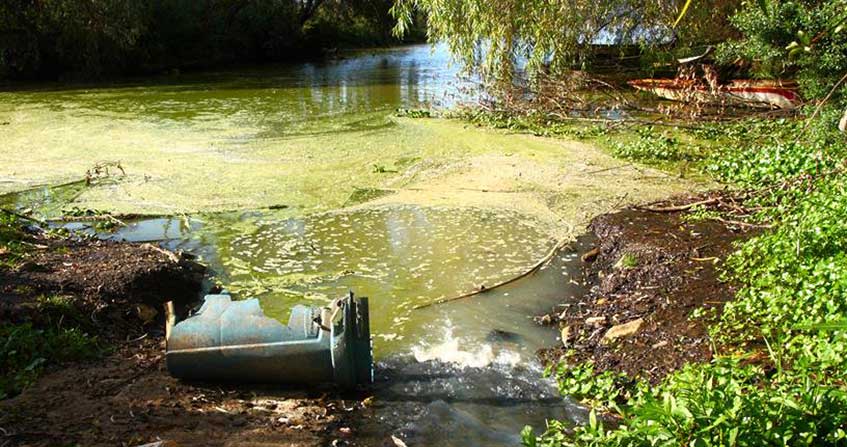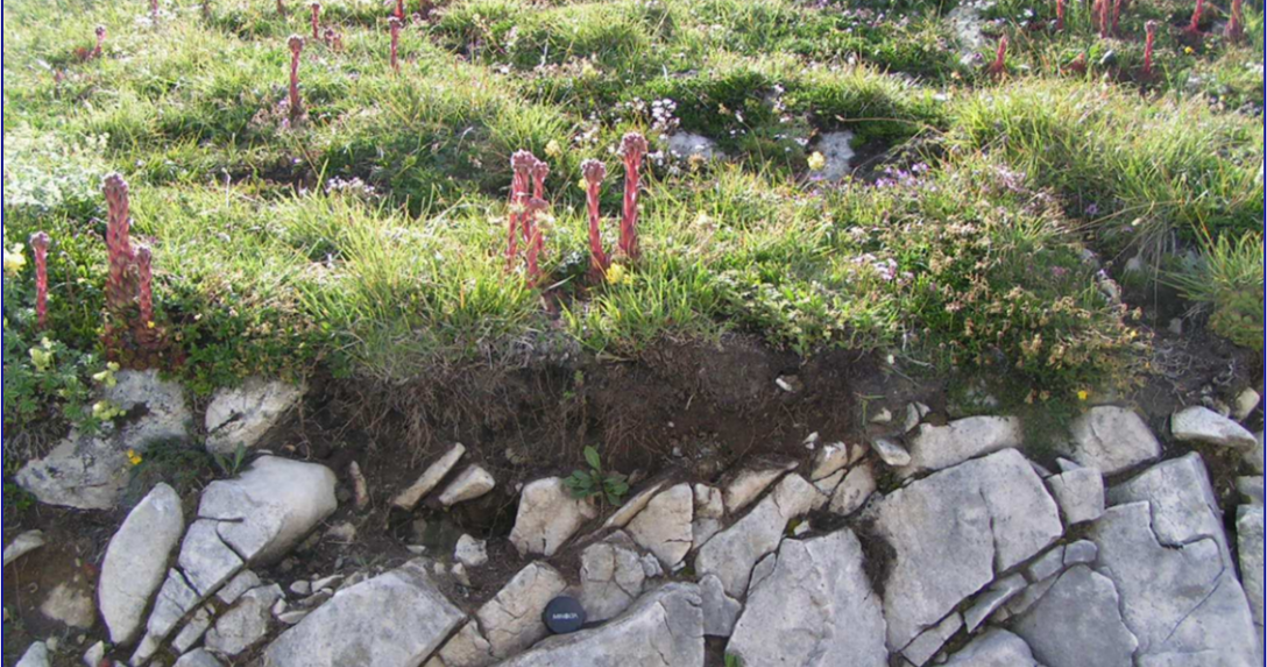The importance of deep soil horizons
PDF
Soils are not restricted to surface humus-bearing horizons. They also include so-called deep horizons that perform essential functions for the development of vegetation. Sometimes absent in very thin soils, deep horizons are the layers of soil between the upper layer more or less rich in organic matter and the underlying unweathered rock. In our climates, they start at a depth of 5 cm (some forms of forest humus) to 30-35 cm (deeply ploughed soils) and range from 10 to 180 cm (sometimes even more).
- 1. Reminder on soil horizons
- 2. Rooting possibilities of annual and perennial plants, cultivated or spontaneous
- 3. Sufficient aeration to allow for biological activity and root development
- 4. Water storage and circulation
- 5. The natural biogeochemical cycle (soil → plants → soil)
- 6. Filtration and purification of rainwater and our liquid effluents
- 7. Trafficability (possibility of passage of farm equipment and large livestock)
- 8. Anecic earthworm habitat
- 9. Carbon storage
- 10. Messages to remember
1. Reminder on soil horizons
It should be remembered that horizons are the superimposed layers of a soil, showing different aspects and properties from each other. This differentiation along a vertical axis is the result of natural phenomena that have followed one another over time over thousands or even hundreds of thousands of years (see Soil formation in temperate climates & Six factors of pedogenesis).
Due to their position (above 30 cm), deep horizons generally remain protected from disturbances related to agricultural tools and are less affected by the summer desiccation phases. Let’s see what roles they play in relation to all the functions we attribute to soils. Schematically, we can count nine of them:
- Agricultural production;
- Forest production;
- Support of vegetation for non-directly productive purposes;
- Balance of local and planetary terrestrial ecosystems (biodiversity, carbon storage);
- Provision of useful materials;
- Geotechnical function (support for various constructions);
- Major role in the water cycle (quality and quantity of surface and groundwater);
- Spreading of wastewaters and other wastes;
- Preservation of the memory of the past (archaeological remains).
Some of these roles are also played by surface horizons, but deep horizons, given their often much larger volume, play a quantitatively more important role.
2. Rooting possibilities of annual and perennial plants, cultivated or spontaneous
2.1 Deep rooting
Annual plants such as spring wheat or corn have little time to establish deep roots, and they take root mainly in the ploughed horizon, where most of the nutrients (fertiliser) are found. However, they can easily reach a depth of 60 cm or even a meter if the soil is suitable. In certain circumstances, such as an exceptional drought, they develop their root system even deeper, in particular to find water (see Focus Water balance of a wheat crop).
On the other hand, it is well known that a perennial crop such as the vine can root up to two meters deep, or even much deeper. The same is true of some forest trees, which are also capable of exploiting cracks in hard rocks over several dozens of metres. But trees can also root laterally, making it possible to explore considerable volumes (see Focus Rooting 150-year-old oaks in thick soil). (See The root system of plants: from the shadows to the light & The tireless-quest for water by plants).
In the case of forest tree species, a very small number of fine roots present at depth can ensure the exploration of water reserves, which is essential during periods of drought, when the upper horizons are dry. Hénin et al. [1] also point out that a root (fine and healthy) can use water within a radius of 1 to 10 cm. It is therefore important never to neglect the description of deep rooting, even if the roots appear to be few in number.
2.2 Obstacles to root penetration

Root penetration is favoured in deep horizons by the existence of a “macroscopic structure” composed of aggregates, which generates all types of connected voids (Figure 1, [2]; see also Part 3). On the other hand, the existence of natural obstacles (of pedological origin) or those caused by human actions are unfavourable to any rooting. These obstacles constitute constraints that are all the more damaging for plants (and therefore for crops) the closer they appear to the surface.
These are:
- Physical obstacles: horizons that are naturally very dense (fragipans) or impermeable (unstructured or swollen clay layers), calcareous crusts or ferruginous accumulations.
- Chemical obstacles: calcium carbonate in the form of very fine particles (“active” lime) is an absolute obstacle to the rooting of strictly calcifuge plants. The same applies to so-called “free” aluminium (i.e. all forms that are neither well-crystallised oxides nor included in silicates) when the soil pH is below 5.5, which can cause a sharp reduction in root growth. The roots become thick and poorly branched and are no longer able to supply the plants with minerals and water. This is known as aluminium toxicity.
- Water barriers: horizons that are even temporarily waterlogged are a major constraint to rooting because of the hypoxic conditions that prevail (Figure 2). This explains the use of drainage techniques in agriculture (drainage using buried pipes, digging ditches). Only certain plant species, such as alders, are adapted to these hypoxic conditions.
- Lastly, there are obstacles created by agricultural practices, such as “plough pans”, thin, compacted levels that sometimes form at the base of the ploughed layer and which young roots will find difficult to penetrate.
2.3 Mechanical anchoring of trees

3. Sufficient aeration to allow for biological activity and root development
In all horizons, even the deepest, the presence of oxygen is necessary for the respiration of all aerobic organisms and roots. Aeration, which depends on the macroscopic structure of each horizon, is necessary for microbial life, without which there would be no mineralization of organic matter, and above all no absorption of nutrients by the roots. In particular, mycorrhizae play a fundamental role in the hydromineral nutrition of most plants.
In deep horizons that are temporarily or almost permanently waterlogged (i.e. poorly aerated), the little residual oxygen is quickly consumed by the microflora and the environment becomes hypoxic and then anoxic. Only anaerobic microorganisms can survive and thrive. The roots of most plants cannot grow there.
4. Water storage and circulation
4.1. Water reservoirs and water reserve in the soil
In the soil, water can be stored and remain accessible to plants within a certain range of void dimensions. Through the largest voids, larger than 10 micrometres (spaces between aggregates, earthworm channels, root holes), rapid spontaneous draining by gravity takes place. In the very small pores and interstices (< 0.2 micrometres), the water is held back too tightly and is inaccessible to the roots. The deep horizons are the main place for storing water useful to plants, both because their volume is at least equal to, and more often than not much greater than, the volume of the surface horizon, and because they are protected from direct evaporation.
The water reservoir is a volume of porosity that can contain water on a long-term basis and is therefore a relatively permanent feature of a horizon or soil. But only part of this reservoir is accessible to plants – it is the “available reservoir”. The available water reserve, on the other hand, is the quantity of available water actually in the reservoir at any given time. The analogy with your car is obvious: its petrol tank may hold up to 60 litres, but it may be half or completely empty.
4.2. Water circulation by capillary rise
In addition to meteoric origin, the water present in deep horizons can come from capillary rise. These originate from a deep water table. In the most favourable cases (horizons with a fine granulometry) they could reach one metre and, in a dry year, reach 100 mm, which would constitute a significant supplement. However, as the water rises through the finest pores, it would not cover the instantaneous needs of the plants and would not supply them sufficiently. This is not to be confused with the special case of chalky soils, which are often very thin and benefit from capillary rise in the mass of chalk that has remained in place. This explains the astonishing fertility of these soils, even though they are thin and highly calcareous.
4.3. Water circulation by hydraulic lift
The circulation of water in the deep horizons, in addition to the phenomena already described, could imply a hydraulic (or hydric) lift phenomenon. This notion, developed in agroforestry, but not proven with certainty for the moment, corresponds to a nocturnal redistribution of water in the soil, from bottom to top, through the roots of trees. Roots in the dry upper horizons would exude water from roots located in the still moist lower horizons [3].
4.4. Stagnation and waterlogging

5. The natural biogeochemical cycle (soil → plants → soil)
Mineral elements present in dissolved forms in the soil solution, essential for the development of plants (such as phosphorus, potassium, calcium, trace elements) or useless or even potentially toxic (such as lead, cadmium, mercury), are absorbed by plant roots from all the horizons actually explored by the roots. Once absorbed by plants, these elements are transferred to their various organs (stems, trunks, branches, leaves, fruits, seeds).
When the plant dies, these elements eventually return to the soil, either directly (in situ decomposition of dead roots) or by falling to the soil surface (debris from aerial parts, forest litter). It is here that fresh organic matter is decomposed more or less rapidly by biological activity (microarthropods including springtails, nematodes, earthworms, fungal filaments, algae, bacteria) until, in the most ‘active’ forms of humus, complete mineralisation is achieved, and chemical elements are released in forms that are fairly mobile and more easily bioavailable.

In agrosystems or production forests, the cycle is broken (Figure 4, arrow 9): [5] humans take some or all of the plants (wheat ears, lettuce, carrots, potatoes, fodder, tree trunks), whether cultivated or not, and take them elsewhere. A greater or lesser proportion of the biomass is therefore exported with the elements it contains. Very generally, food products (flour, vegetables, fruit), wood and their waste (wheat husks, peelings, human or animal excrement, sawdust, fire ashes) are not returned to the place where they were taken. This results in a gradual impoverishment of the environment as the harvests progress. In forest areas, this can lead to progressive soil acidification. The “poorest” ecosystems quickly become unbalanced and wither away. In agriculture (even organic) it is therefore essential to return to the soils all the elements (nitrogen, phosphorus, potassium, calcium, trace elements, organic matter) that have been removed from them, this is the reason for the addition of fertilizers and soil improvers (organic, calcareous). Under intensive farming, where exports are massive, this need for restitution is even more imperative.
6. Filtration and purification of rainwater and our liquid effluents
Soil is a porous medium that acts as a mechanical filter and chemical and biological reactor for nitrates, phosphates, and certain pesticides in relation to the water that flows through it and the substances that are dissolved or suspended in it. In addition to purely mechanical filtering that blocks solid particles, surface reactions with clay minerals, organic matter, certain oxyhydroxides and biochemical reactions by the action of microorganisms take place.
This is why, in the natural environment, the chemical and biological quality of deep waters depends on the mineralogical properties and pH of the soils through which they pass. They are loaded with organic substances or calcium, magnesium, etc.
This “purifying power” has long been used by humans to purify their wastewater. But this purification capacity is not unlimited, and there is a risk that spreading wastewater can pollute the receiving soil. A famous example is that of the untreated water of the Paris conurbation, spread massively on the plain of Pierrelaye and other sewage spreading fields (Triel-sur-Seine, Gennevilliers) for market gardening [6]!
Considered at the end of the 19th century as a hygienic solution to the disposal of water from Parisian sewers, this practice of massive irrigation proved to be heavily polluting. It is true that during the twentieth century the quality of wastewater had completely deteriorated as a result of the industrialization of the suburbs. In addition to organic matter of human origin, many trace metals have been added, including lead, cadmium, mercury, etc. in considerable doses, which led the authorities to ban agriculture.
7. Trafficability (possibility of passage of farm equipment and large livestock)

It is therefore important to maintain satisfactory macroporosity in all horizons in order to maintain the soil’s natural ability to drain vertically. If necessary, excess water should be removed by appropriate techniques(drainage by pipes, ditches).
8. Anecic earthworm habitat

In forests, they are essential in the formation of mull-type humus as they ensure the rapid and intimate association of organic matter with mineral matter, in particular clay (clay-humic complex), in surface horizons. On the contrary, they are absent in acidic forest soils.
9. Carbon storage


Peatlands are a special case of constant accumulation of plant organic matter with little or no decomposition in a waterlogged environment. As soon as the water level is lowered to allow the plot to be cultivated, organic matter mineralizes spontaneously and carbon destocking is observed and, eventually, the disappearance of peat. Soil scientists refer to these entirely organic soils as histosols. (See Peatlands and marshes, remarkable wetlands).
10. Messages to remember
- Soils are not limited to humus-rich surface horizons. They also include so-called deep horizons that perform essential functions, in particular for the development of vegetation.
- The macroscopic structure of these horizons (existence, sizes and shapes of aggregates; dimensions, connectivity and arrangement of voids) remains fundamental for everything related to the circulation and storage of water, aeration and therefore the biological activity on which the development and life of plant roots depend.
- The primary interest of a deep, well-distributed and healthy root system lies not only in good anchoring and nutrition of the plant, but above all in the use of the soil’s water reserve, proportional to the volume prospected. This depends on the lateral distribution of the roots and not only on the depths reached.
- This is why many authors insist on the practical importance of the macroscopic structure of soils: “The development and maintenance of a desirable and optimal soil structure for plant growth is an eternal requirement in agriculture“. [10]
- And this is true for the entire thickness of the soil, not just for the surface horizon reworked by agricultural tools.
Notes and references
Cover image. Source Photo Jacques Roque, reproduite avec l’autorisation de l’auteur.
[1] Hénin, S., Gras, R. et Monnier, G. (1969). Le profil cultural. Paris, Masson, 332 p., (in french).
[2] Rowell, D.L. (1994). Soil Science: methods and applications. Longman Scientific & Technical. 350 p., (in french).
[3] Dupraz, C. (2009). L’ascenseur hydraulique ou comment les arbres redistribueraient l’eau du sol. Agroforesteries, n° 02, pp. 13-18, (in french).
[4] Concaret, J. (coord.) (1981). Drainage agricole. Théorie et pratique. Chambre régionale d’agriculture de Bourgogne, Dijon. 509 p., (in french).
[5] Baize, D. (2007). Les Éléments Traces Métalliques (ETM) dans les sols. Cours à l’Université de Poitiers, (in french).
[6] Baize, D., Lamy, I., vanOort, F., Dère, C., Chaussod, R., Sappin-Didier, V., Bermond, A., Bourgeois, S., Schmitt, C., Schwartz, C. (2002). 100 years spreading of urban waste water on market-garden soils close to Paris (France) : subsequent impacts and hazards. 17th World Congress of Soil Science, Bangkok. Symposium 29, paper n° 204.
[7] Baize, D. (2012). Les « terres d’Aubues » de Basse Bourgogne : nouvelle synthèse et bilan de matières à très long terme. Étude et Gestion des Sols, 19, 3-4, pp. 139-161, (in french).
[8] AFES. (2009). Référentiel pédologique 2008. D. Baize et M.C. Girard (coord.). Quae éditions. Paris. 432 p., (in french).
[9] Derrien, D. et coll. (2016). Stocker du carbone dans les sols : quels mécanismes, quelles pratiques agricoles, quels indicateurs ? Étude et Gestion des Sols, Vol. 23, pp. 193 à 223, (in french).
[10] Hillel, D. (1988). L’eau et le sol. Principes et processus physiques. 2ᵉ édition. Pédasup 5, Academia, Louvain-la-Neuve, 294 p., (in french).
The Encyclopedia of the Environment by the Association des Encyclopédies de l'Environnement et de l'Énergie (www.a3e.fr), contractually linked to the University of Grenoble Alpes and Grenoble INP, and sponsored by the French Academy of Sciences.
To cite this article: BAIZE Denis (January 5, 2025), The importance of deep soil horizons, Encyclopedia of the Environment, Accessed April 24, 2025 [online ISSN 2555-0950] url : https://www.encyclopedie-environnement.org/en/soil/importance-deep-soil-horizons/.
The articles in the Encyclopedia of the Environment are made available under the terms of the Creative Commons BY-NC-SA license, which authorizes reproduction subject to: citing the source, not making commercial use of them, sharing identical initial conditions, reproducing at each reuse or distribution the mention of this Creative Commons BY-NC-SA license.







